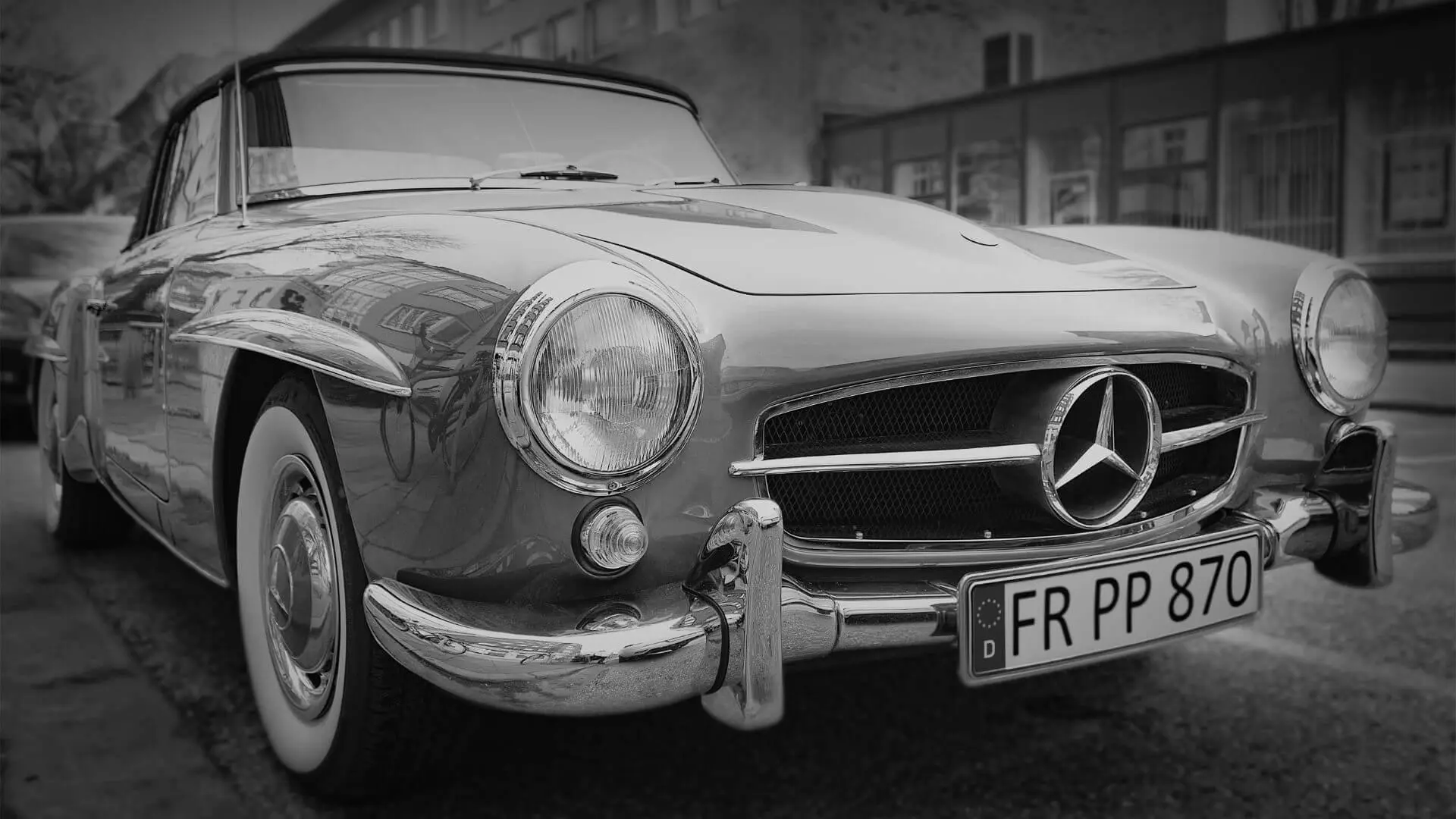The classic car market is expected to grow to a whopping 60 billion by 2032, showing how much love people have for these vintage beauties. However, when hiring classic car auto transport companies to move them safely, that love is truly tested because you must trust a stranger. This is where this guide will help you by providing key insights into hiring the best vintage car movers:
Do People Use Enclosed Carriers for Classic Cars?
Yes, most of the classic cars are shipped using enclosed carriers because of the added security they provide. The US classic market is huge, and classic cars represent 15.2% of the total registered vehicles in the US. This means out of 283 million registered cars in the US as of 2022, 43 million are classic cars. Here’s a visual representation of the data:

Data Sources:
According to this data, nearly 75% of classic cars are US-made. Plus, most of these cars are actively driven on the road. In fact, according to Hagerty, 90% of classic car owners are also looking forward to attending auto shows with their vintage rides.
Both of these reasons show that classic cars are more than just showpiece items forever parked in garages. This means people frequently transport their vintage vehicles when moving homes or going to auto shows, and seeing that, we can easily get an idea of the high demand for enclosed carriers.
The price difference between open and enclosed is not that high either. Sure, it’s at least 30% higher, but in numbers, that’s just a few hundred bucks more, and for any classic car enthusiast, just a few hundred dollars extra is worth it. Here’s the comparison of costs of shipping a classic car in enclosed vs open carriers:

As you can see, the difference between both is not that high, but enclosed shipping can be a better financial decision. Here’s why:
- With the US classic car market valued at $1 trillion across 43 million vehicles, the average classic car value is approximately $23,256
- The additional cost for enclosed transport ranges from $200-400, representing only 0.33-0.44% of the average classic car’s value.
- Given that 75% of actively driven classic cars are American-made and often need transportation to shows and events, enclosed transport offers crucial protection for these valuable assets
The minimal cost difference provides significant additional protection against extreme weather, road debris, and other potential hazards during transport
2 Types of Auto Transport Services for Classic Cars
When you’re looking to move your prized classic car, you’ll want to know exactly what options are out there. Let me break down the main types of services you’ll come across when searching for classic car auto transport companies.
Brokers vs. Direct Carriers
Think about brokers as professional matchmakers in the car shipping industry. When you search for “classic car transport near me,” these established businesses often appear first. While they don’t own trucks, they connect you with qualified carriers – but there’s more to them than being middlemen.
Most reputable brokers are FMCSA-registered Limited Liability Companies (LLCs) with physical office locations. This means they’re legitimate businesses that have met federal insurance, safety, and business practices standards. When you work with a registered broker, you deal with a company with a real stake in the industry and maintain its reputation.
| Broker Features | Direct Carrier Features |
|---|---|
| Multiple price options | Direct control over transport |
| Flexible scheduling | Specialized equipment ownership |
| Wider carrier network | Consistent crew training |
| FMCSA registration | Owner-operated equipment |
| Physical business location | Direct oversight of operations |
Here’s the real scoop about brokers: they typically save money and time by quickly finding available carriers. Their established networks and relationships in the classic car transport industry mean they can often secure better rates. Yes, you won’t know your specific carrier immediately, but reputable brokers carefully vet their carrier network.
Direct carriers operate differently - they’re owner-operators handling everything themselves. You might pay slightly less since there’s no middleman, and you’ll work with a team specializing in classic cars. This direct relationship provides excellent accountability for that pristine ‘57 Chevy or vintage Mustang.

Consider your specific preferences when choosing between the two for car transport services. Brokers offer flexibility and established business credentials, while direct carriers provide hands-on control. Both options can safely transport your classic - it’s about finding what works best for your situation.
Service Options
When it comes to classic car auto transport, you have some choices about how your vehicle travels.
| Transport Type | Best For | Price Range |
|---|---|---|
| Enclosed Transport | Show cars, rare models | $$$ |
| Open Transport | Project cars, drivers | $$ |
Enclosed transport keeps your classic completely covered. Your ‘65 Corvette won’t see a single raindrop or piece of road debris. Moreover, most enclosed carriers now use air-ride suspension - your car basically rides on a cushion of air.
Open transport works fine for project cars or classics you drive regularly. Sure, your car will be exposed to the weather, but you’ll save some serious cash.
Add-ons With Classic Car Shipping Services
Sometimes, you need extra services to make sure your classic gets the royal treatment:
Need your car picked up right away? Expedited service gets you next-day pickup. It’ll cost extra, but it’s super helpful during a time crunch.
Lift gates are crucial if your project car isn’t running - they’re basically giant elevators for your car.
GAP coverage gives you extra protection beyond basic insurance. For a numbers-matching GTO or other valuable classics, it’s probably worth considering. Just make sure to read exactly what’s covered.
| Service | What You Get | Worth It? |
|---|---|---|
| Expedited Pickup | 24-hour pickup window | Yes, if time-sensitive |
| GAP Coverage | Extra insurance protection | Yes, for high-value cars |
| Lift Gate Service | Special loading equipment | Essential for non-running cars |
How Do I Find Classic Car Transport Near Me? 5 Key Considerations
Moving a classic car isn’t like shipping any regular vehicle. You’ll want to look into several key factors to ensure your trusty ride arrives safely at its destination. Let’s see what matters when choosing classic car auto transport companies.

Insurance Coverage
When it comes to classic car transport, insurance is absolutely crucial. You’re not just moving metal - you’re transporting history on wheels.
| Coverage Type | Recommended Minimum | What It Protects |
|---|---|---|
| Cargo Insurance | $1,000,000+ | Your vehicle during transit |
| Gap Coverage | Value-based | Modified or custom parts |
Think about this: your ‘32 Ford hot rod isn’t just worth its parts. Those custom modifications and countless restoration hours need proper coverage. That’s where agreed value policies come in. These policies let you and the insurer agree beforehand on your car’s actual worth.
| Vehicle Type | Special Coverage Needs |
|---|---|
| Pre-war Classics | Vintage glass, irreplaceable trim |
| Resto-mods | Custom parts, modern upgrades |
| Show Cars | Perfect finish, chrome work |
Company Reputation and Experience
Classic car auto transport requires specialized knowledge. You wouldn’t let anyone work on your classic - don’t let anyone transport it, either.
Besides being FMCSA licensed with a USDOT number and BBB verified with A+ ratings, they should have at least some exposure to classic car communities and clubs.
Real reviews from classic car communities or collectors matter more than generic online ratings. Ask around at car shows and talk to restoration shops. These folks know who really takes care of vintage vehicles.
Look for companies that understand different eras. Handling a delicate Pierce-Arrow isn’t the same as moving a muscle car. The right transporter will know all the quirks - like how to handle mechanical brakes or where to safely lift a car with side pipes.
When problems arise, good companies step up. They should have clear processes for addressing concerns and handling claims. Ask them directly: “What happens if something goes wrong?” Their answer tells you a lot about their experience level.
| Red Flags | Green Flags |
|---|---|
| No specific classic car experience | Detailed loading procedures |
| Vague insurance answers | Classic Car Club references |
| No physical business location | Documented classic transport history |
Transport Equipment and Methods
Safely moving a precious classic requires the right tools and know-how. When searching for Classic Car Auto Transport, you’ll want to understand exactly what equipment they’re using to protect your investment.
| Equipment Type | Features to Look For | Why It Matters |
|---|---|---|
| Enclosed Trailers | Air-ride suspension, climate control | Protects from road vibration and weather |
| Loading Systems | Hydraulic lifts, extended ramps | Safe loading for low-clearance vehicles |
| Securing Equipment | Soft straps, wheel cradles | Prevents damage to finishes and wheels |
Think about your car’s specific needs. A ’30s Packard with wooden wheels needs different care than a ’60s muscle car. Professional classic car transport services use special soft straps that won’t harm chrome or paint. Wheel nets provide perfect protection for those irreplaceable wire wheels.
Climate control isn’t just a luxury—it’s essential for cars with original leather or wood components. Good transporters monitor temperature and humidity throughout the journey, preventing warping, cracking, or moisture damage to these sensitive materials.
Cost Factors
The price tag for moving your classic isn’t one-size-fits-all. Several factors affect what you’ll pay for quality transport.
| Factor | Impact on Cost | Considerations |
|---|---|---|
| Vehicle Size | Higher for larger cars | Pre-war cars often need more space |
| Condition | Extra for non-runners | Special loading equipment needed |
| Season | Peak during show months | Book early for better rates |
Timing matters more than you might think. Auction season means higher demand and prices. Planning your transport during off-peak times could save you money. But remember - saving a few bucks isn’t worth risking damage to your classic.
Route planning gets complicated with vintage cars. Good transporters consider weather patterns and road conditions. They avoid rough highways that might shake loose those original parts and plan climate-controlled stops for wooden-bodied vehicles.
| Special Requirements | Additional Cost Range |
|---|---|
| Enclosed Transport | 30-50% more than open |
| White Glove Service | Premium pricing |
| Special Insurance | Based on the agreed value |
Insurance costs vary based on your car’s unique features. Documented racing history or recent concours restoration affect coverage needs and costs. Make sure your transporter understands what makes your classic special and ensures it accordingly.
Communication Levels
When you contacted them to get quotes, how was their support?
- Were they professional?
- Were they friendly and helpful?
- Were they quick?
- Were they thorough?
- Were they pushy?
- Did they communicate prices and services clearly and transparently?
These things make a huge difference because you don’t need them just for the car shipping quote; you’ll be relying on their support throughout the process for updates. And if the vehicle arrives with any issues, you’ll need the support again for the claims process.
5 Pre-Transport Preparations For Classic Car Shipping
Proper preparation is crucial before you hand over your precious classic to any classic car auto transport company. Getting your vintage ride ready for transport involves several key steps that can make a huge difference in how smoothly things go.

1. Vehicle Assessment
Start by giving your classic car a thorough once-over to document its current condition. Here are the key things to check:
- Document vehicle width - especially critical since enclosed trailers only have 81 inches from fender to fender
- Note that if the car has extended fenders that affect visibility during loading, this is critical for 1930s cars like Cadillacs.
- Document tire width - particularly important for vintage cars with very narrow tires as they can slip off loading ramps easily
- Check suspension height and if the car is “slammed” or lowered, which affects the loading angle.
- Assess steering responsiveness as classic cars have much looser steering than modern vehicles.
For example, if you have a 1959 Cadillac Eldorado Biarritz, those iconic big fins mean your car is wider than most. You’ll definitely want an enclosed trailer wide enough to accommodate it. Classic tire widths are often much narrower than modern ones. A 1920s Ford Model A has tires only about 4 inches wide, compared to 8-10 inches on a typical car today.
2. Mechanical Preparation
Your classic’s mechanical condition affects how classic car auto transport will handle the loading process. Those old manual transmissions and loose steering systems need special attention.
| System Check | Action Required | Impact on Transport |
|---|---|---|
| Fluid Systems | Check for leaks | Prevents damage to other vehicles |
| Starting System | Test reliability | Affects the loading/unloading process |
| Brakes | Verify function | Critical for secure transport |
3. Documentation Package
With your vehicle assessed and prepped, it’s time to put together your documentation package. This is super important for insurance purposes and as a record of your car’s condition.
Take lots of detailed photos of every angle of the car, inside and out. Get close-ups of any existing damage or quirks. The transport driver will do their own inspection, but you also want your own record.
It’s also good to thoroughly clean your classic before the inspection photos. This will make it easier to spot any new damage that might happen during transport.
Another critical tip: Remove ALL personal belongings from the car. Transport insurance will not cover these items if they’re lost or damaged; only the vehicle itself is protected.
4. Interior Preparation
In addition to clearing out personal items, take some time to prep and protect the interior of your classic.
Make detailed notes about any quirks in the car’s operation, like a tricky starter button or finicky door latch. The driver needs to be aware of these to avoid damage.
Document any special starting or handling procedures thoroughly as well. For example, some old cars require pumping the gas pedal a certain way while cranking.
Delicate upholstery and vintage materials, like plastic wrap or custom-fit covers, may need extra protection. Secure or remove any loose floor mats or accessories.
5. Exterior Protection
Your car’s exterior deserves extra attention. Convertibles with soft tops need enclosed transport, and those special paint finishes require additional protection. Consider waxing the exterior for added paint protection.
| Feature | Protection Needed | Transport Requirements |
|---|---|---|
| Convertible Tops | Weather protection | Enclosed transport required |
| Custom Paint | Dust/debris protection | Special covering needed |
| Low Components | Loading clearance | Special ramps/lifts required |
Remember to book your transport well in advance - at least a month ahead, especially if you need enclosed transport. Good carriers get booked up quickly, particularly during show season.
Always Ask Questions From Classic Car Auto Transport Companies
When searching for reliable classic car auto transport companies, asking some crucial questions can help filter amateurs. Here are some examples of questions you can ask:
| Area of Concern | What to Ask | Red Flag Response |
|---|---|---|
| Model Experience | “Have you moved my car’s model before?” | Vague or dismissive answers |
| Loading Process | “How do you handle extended fenders?” | No specific procedure |
| Tire Protection | “What about narrow vintage tires?” | Standard ramps only |
A qualified transporter should immediately understand concerns about convertible tops and special paint finishes. If they brush off these worries or lack specific protection methods, keep looking. Your classic deserves better care.
Remember: Good car transporters welcome detailed questions about their experience and equipment. If they get defensive or evasive, consider it a warning sign. Your irreplaceable classic needs a company that takes pride in its expertise and willingly demonstrates its knowledge.
Cost Expectations For Classic Car Shipping Services
Understanding pricing for classic car shipping helps you budget properly and avoid surprises. Let’s break down what affects your costs when looking for classic car transport services.
Base Rate Breakdown
The foundation of shipping costs starts with distance, but several factors influence your final price. Most Classic car auto transport begins at $1.30 per mile for shorter trips, dropping to around $0.60 per mile for cross-country journeys.
| Distance | Enclosed Base Rate (Per Mile) | Example Total Cost |
|---|---|---|
| Under 500 miles | $1.30-$1.50 | $650-750 |
| 700-1500 miles | $1.00-0.80 | $750-1,200 |
| Over 1500 miles | $0.60 | $1,200+ |
Seasonal and Location Factors
Timing and location significantly impact shipping costs. Due to high demand, expect premium rates during major events like Monterey Car Week or Barrett-Jackson auctions.
| Timing/Location | Cost Impact | Planning Tips |
|---|---|---|
| Major Auto Events | +5-10% | Book 2-3 months ahead |
| Remote Locations | +10-15% | Consider terminal delivery |
| Special Routes | +15-20% | Flexible scheduling helps |
Special handling requirements add more to your bill. If your classic needs a forklift for loading, expect to pay $150-200 extra. Non-running vehicles typically incur an additional $100 fee for winching and special equipment.
Classic Car Shipping Cost-Saving Tips
While you shouldn’t cut corners with classic car shipping, some smart planning can help manage costs. Booking during off-peak seasons (typically winter months) often saves 10-20%. Terminal-to-terminal shipping, rather than door-to-door service, can reduce costs by 10% or more.
| Saving Strategy | Potential Savings | Considerations |
|---|---|---|
| Off-peak Shipping | 10-15% | Weather concerns |
| Terminal Service | 10% | Additional driving needed |
| Flexible Dates | 5% | Longer delivery window |
Easy Auto Ship Offers VIP Classic Car Transport Experience
Shipping your classic vehicles is not just about ensuring safety. Granted, security is the #1 factor, but a seamless experience is another reason why a premium classic car shipping company like Easy Auto Ship is your best bet.
So, if you’re interested in getting free estimates for classic car transport, call us at (888) 687-3243 or use our free, no-obligation car shipping quote calculator.





